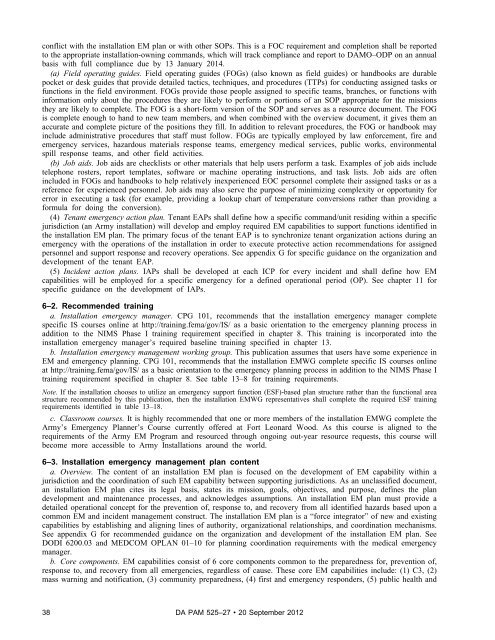Army Emergency Management Program - Federation of American ...
Army Emergency Management Program - Federation of American ...
Army Emergency Management Program - Federation of American ...
Create successful ePaper yourself
Turn your PDF publications into a flip-book with our unique Google optimized e-Paper software.
conflict with the installation EM plan or with other SOPs. This is a FOC requirement and completion shall be reported<br />
to the appropriate installation-owning commands, which will track compliance and report to DAMO–ODP on an annual<br />
basis with full compliance due by 13 January 2014.<br />
(a) Field operating guides. Field operating guides (FOGs) (also known as field guides) or handbooks are durable<br />
pocket or desk guides that provide detailed tactics, techniques, and procedures (TTPs) for conducting assigned tasks or<br />
functions in the field environment. FOGs provide those people assigned to specific teams, branches, or functions with<br />
information only about the procedures they are likely to perform or portions <strong>of</strong> an SOP appropriate for the missions<br />
they are likely to complete. The FOG is a short-form version <strong>of</strong> the SOP and serves as a resource document. The FOG<br />
is complete enough to hand to new team members, and when combined with the overview document, it gives them an<br />
accurate and complete picture <strong>of</strong> the positions they fill. In addition to relevant procedures, the FOG or handbook may<br />
include administrative procedures that staff must follow. FOGs are typically employed by law enforcement, fire and<br />
emergency services, hazardous materials response teams, emergency medical services, public works, environmental<br />
spill response teams, and other field activities.<br />
(b) Job aids. Job aids are checklists or other materials that help users perform a task. Examples <strong>of</strong> job aids include<br />
telephone rosters, report templates, s<strong>of</strong>tware or machine operating instructions, and task lists. Job aids are <strong>of</strong>ten<br />
included in FOGs and handbooks to help relatively inexperienced EOC personnel complete their assigned tasks or as a<br />
reference for experienced personnel. Job aids may also serve the purpose <strong>of</strong> minimizing complexity or opportunity for<br />
error in executing a task (for example, providing a lookup chart <strong>of</strong> temperature conversions rather than providing a<br />
formula for doing the conversion).<br />
(4) Tenant emergency action plan. Tenant EAPs shall define how a specific command/unit residing within a specific<br />
jurisdiction (an <strong>Army</strong> installation) will develop and employ required EM capabilities to support functions identified in<br />
the installation EM plan. The primary focus <strong>of</strong> the tenant EAP is to synchronize tenant organization actions during an<br />
emergency with the operations <strong>of</strong> the installation in order to execute protective action recommendations for assigned<br />
personnel and support response and recovery operations. See appendix G for specific guidance on the organization and<br />
development <strong>of</strong> the tenant EAP.<br />
(5) Incident action plans. IAPs shall be developed at each ICP for every incident and shall define how EM<br />
capabilities will be employed for a specific emergency for a defined operational period (OP). See chapter 11 for<br />
specific guidance on the development <strong>of</strong> IAPs.<br />
6–2. Recommended training<br />
a. Installation emergency manager. CPG 101, recommends that the installation emergency manager complete<br />
specific IS courses online at http://training.fema/gov/IS/ as a basic orientation to the emergency planning process in<br />
addition to the NIMS Phase I training requirement specified in chapter 8. This training is incorporated into the<br />
installation emergency manager’s required baseline training specified in chapter 13.<br />
b. Installation emergency management working group. This publication assumes that users have some experience in<br />
EM and emergency planning. CPG 101, recommends that the installation EMWG complete specific IS courses online<br />
at http://training.fema/gov/IS/ as a basic orientation to the emergency planning process in addition to the NIMS Phase I<br />
training requirement specified in chapter 8. See table 13–8 for training requirements.<br />
Note. If the installation chooses to utilize an emergency support function (ESF)-based plan structure rather than the functional area<br />
structure recommended by this publication, then the installation EMWG representatives shall complete the required ESF training<br />
requirements identified in table 13–18.<br />
c. Classroom courses. It is highly recommended that one or more members <strong>of</strong> the installation EMWG complete the<br />
<strong>Army</strong>’s <strong>Emergency</strong> Planner’s Course currently <strong>of</strong>fered at Fort Leonard Wood. As this course is aligned to the<br />
requirements <strong>of</strong> the <strong>Army</strong> EM <strong>Program</strong> and resourced through ongoing out-year resource requests, this course will<br />
become more accessible to <strong>Army</strong> Installations around the world.<br />
6–3. Installation emergency management plan content<br />
a. Overview. The content <strong>of</strong> an installation EM plan is focused on the development <strong>of</strong> EM capability within a<br />
jurisdiction and the coordination <strong>of</strong> such EM capability between supporting jurisdictions. As an unclassified document,<br />
an installation EM plan cites its legal basis, states its mission, goals, objectives, and purpose, defines the plan<br />
development and maintenance processes, and acknowledges assumptions. An installation EM plan must provide a<br />
detailed operational concept for the prevention <strong>of</strong>, response to, and recovery from all identified hazards based upon a<br />
common EM and incident management construct. The installation EM plan is a “force integrator” <strong>of</strong> new and existing<br />
capabilities by establishing and aligning lines <strong>of</strong> authority, organizational relationships, and coordination mechanisms.<br />
See appendix G for recommended guidance on the organization and development <strong>of</strong> the installation EM plan. See<br />
DODI 6200.03 and MEDCOM OPLAN 01–10 for planning coordination requirements with the medical emergency<br />
manager.<br />
b. Core components. EM capabilities consist <strong>of</strong> 6 core components common to the preparedness for, prevention <strong>of</strong>,<br />
response to, and recovery from all emergencies, regardless <strong>of</strong> cause. These core EM capabilities include: (1) C3, (2)<br />
mass warning and notification, (3) community preparedness, (4) first and emergency responders, (5) public health and<br />
38 DA PAM 525–27 20 September 2012
















